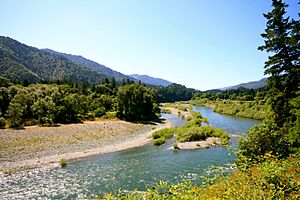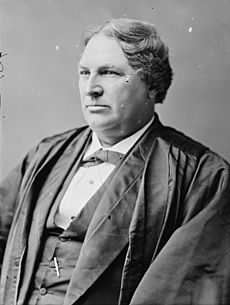United States v. Kagama facts for kids
Quick facts for kids United States v. Kagama |
|
|---|---|

|
|
| Submitted May 10, 1886 Argued March 2, 1886 |
|
| Full case name | United States v. Kagama, alias Pactah Billy, an Indian, and another. |
| Citations | 118 U.S. 375 (more)
6 S. Ct. 1109; 30 L. Ed. 228; 1886 U.S. LEXIS 1939
|
| Holding | |
| The Major Crimes Act was constitutional, and, therefore, the case was within the jurisdiction of the federal courts. This ruling meant that the San Francisco Court's indictment would stand. | |
| Court membership | |
| Case opinions | |
| Majority | Miller, joined by unanimous |
| Laws applied | |
| U.S. Const. Art. I, § 8, cl. 3; 18 U.S.C. § 1153 | |
United States v. Kagama was an important case decided by the U.S. Supreme Court in 1886. The Court decided that a law called the Major Crimes Act of 1885 was constitutional. This law gave federal courts the power to hear cases about certain serious crimes that happened between Native Americans on reservations.
The case involved a Yurok Native American named Kagama. He was accused of a serious crime. The Department of Justice chose his case to test if the new Major Crimes Act was legal. The Supreme Court's decision confirmed that the U.S. Congress had the power to make laws about Native American affairs. This power was seen as coming from the tribes' status as "dependent domestic nations."
Contents
Understanding the Case: Background
The Hoopa Valley Reservation
The Hoopa Valley Reservation was created in 1864. It was set up by a special order from the government. At that time, three different Native American groups lived along the Klamath River. These groups were the Yurok, the Karuk, and the Hupa. Each group had its own language and traditions.
These tribes had their own long-standing rules about land and property. They knew how land was passed down through families. Sometimes, families owned land far from their main village.
A Property Dispute
The person in charge of the reservation was an "Indian agent" named Charles Porter. He was also in command of the local military fort. Agent Porter started giving small pieces of land to individual Native American people. This went against the old family property system.
Agent Porter had to help settle land disagreements many times. Kagama and another person named Iyouse had a dispute over land. Kagama had built his home on land he wanted to own. This disagreement was a key part of the background to the court case.
The Supreme Court Case
Arguments Presented
Kagama was represented by a lawyer named Joseph D. Redding. The U.S. government's side was argued by George A. Jenks. The Supreme Court heard the arguments in May 1886.
Jenks argued that Congress had the power to make laws about Native American tribes. He pointed to earlier court comments and laws Congress had passed. He said the U.S. government should be able to enforce its laws everywhere within its borders.
Joseph Redding strongly defended Kagama. He made three main points:
- For 100 years, Congress had not prosecuted crimes between Native Americans.
- The crime Kagama was accused of did not involve trade, so Congress should not have power over it.
- He argued that such a big change in policy should be openly debated. He said Congress could not take power over tribes that had kept certain rights in treaties.
The Court's Decision
In May 1886, the Supreme Court made a unanimous decision. Justice Samuel Freeman Miller wrote the opinion. The Court ruled that the Major Crimes Act was constitutional. This meant that federal courts did have the power to hear Kagama's case.
Justice Miller said that the case was not about trade. Instead, he said it was necessary because Native Americans were "wards" of the United States. This meant they were seen as needing the U.S. government's protection and guidance. The Court's decision allowed Kagama's case to go to trial in California.
The language used in Justice Miller's opinion described Native American tribes as weak and dependent on the federal government. This language has been criticized by many people later on. The decision did not clearly state where in the Constitution Congress got this power.
What Happened Next
Kagama's Trial
Kagama's trial took place in San Francisco in September 1886. The prosecution called witnesses, including Iyouse's wife. Kagama's defense lawyer called one witness, John B. Treadwell. Treadwell said that the crime happened outside the reservation's boundaries. The judge believed Treadwell and ordered Kagama to be found not guilty.
The local sheriff, T. M. Brown, also said he would not arrest Kagama. He explained that in his 26 years, the state had never prosecuted a Native American for a crime against another Native American. The sheriff also said Kagama was a good person and that the victim had caused trouble.
Impact and Criticism of the Decision
The Kagama case was very important because it established Congress's "plenary power" over Native American tribes. "Plenary power" means complete or absolute power. This decision helped Congress pass other laws, like the Dawes Act. These laws took away many freedoms Native Americans had.
In the late 1800s and early 1900s, many U.S. lawmakers believed Native Americans should adopt Euro-American culture. The laws that followed the Kagama ruling tried to force tribes to change their ways.
Many legal experts have criticized the Kagama decision. They argue that the Constitution does not clearly give Congress such broad power over Native American affairs. Some have called the decision "circular reasoning" because it said tribes were weak, partly due to their dealings with the U.S. government, and then used that weakness to justify more federal power.
Despite the criticism, Kagama is still considered "good law." This means it is still used as a legal precedent in courts today. It has been cited in Supreme Court cases as recently as 2004. In 2010, a Pawnee lawyer named Walter Echo-Hawk wrote that Kagama has been used to justify too much government control over Native American tribes and their lives.



